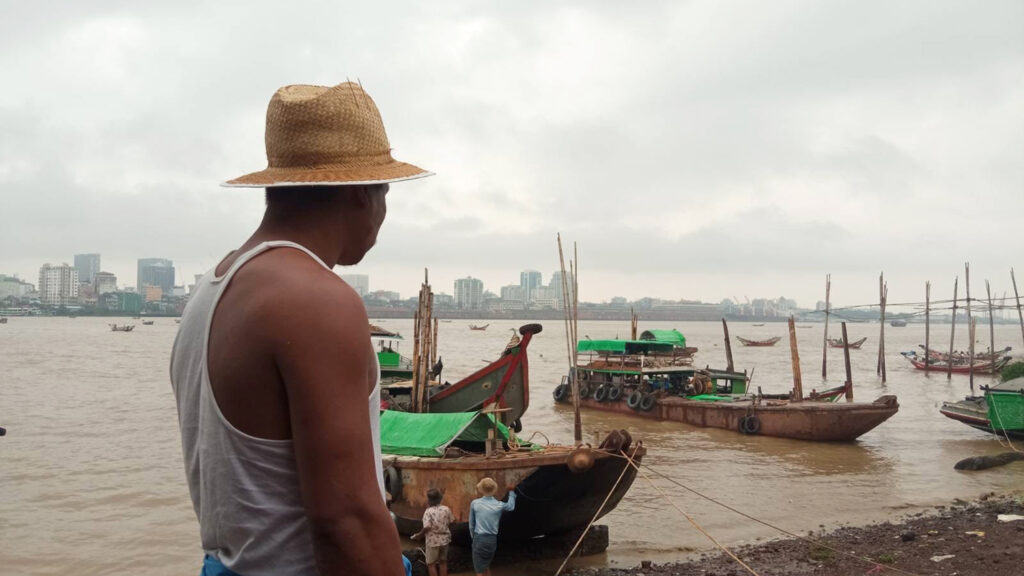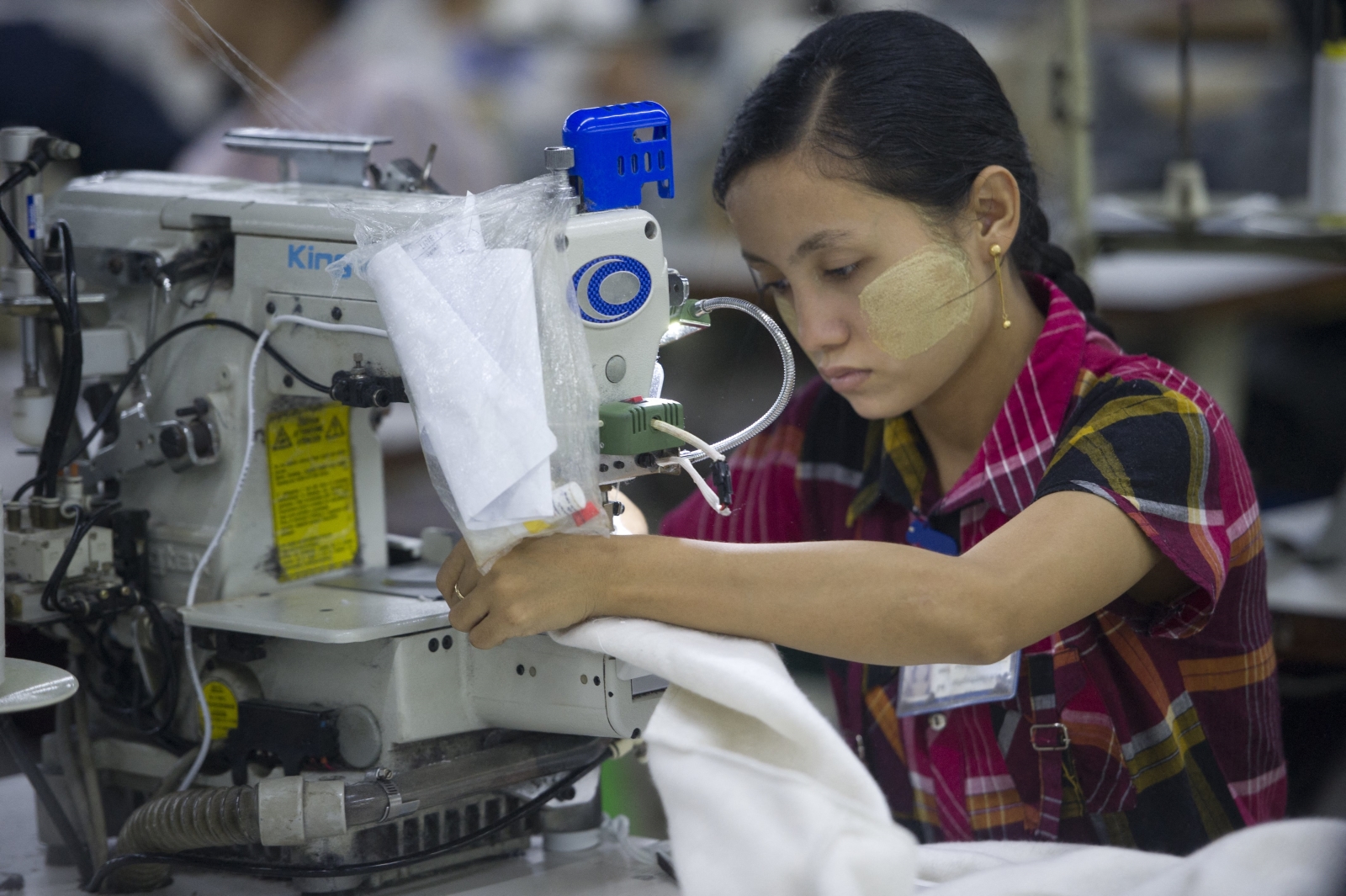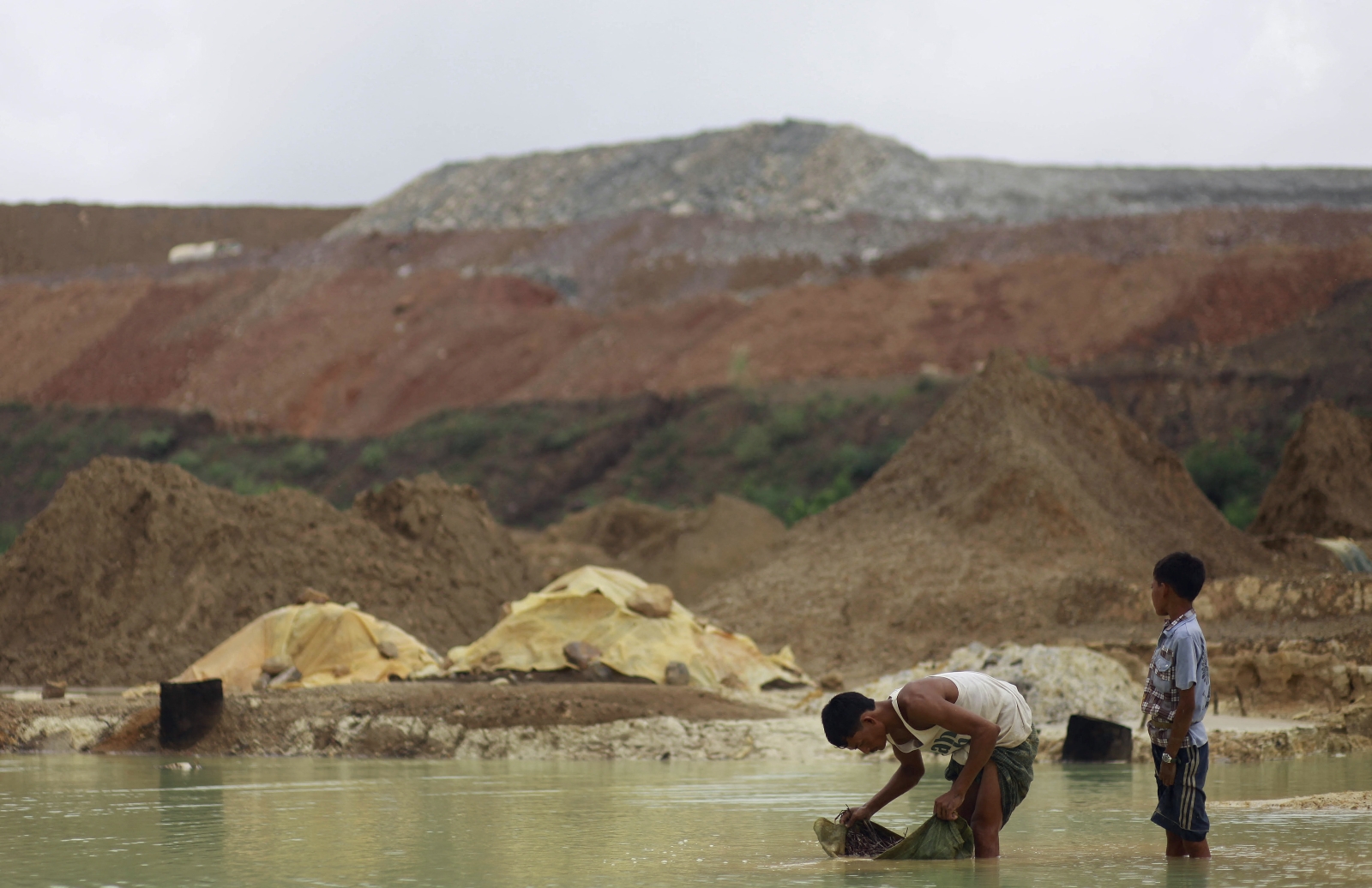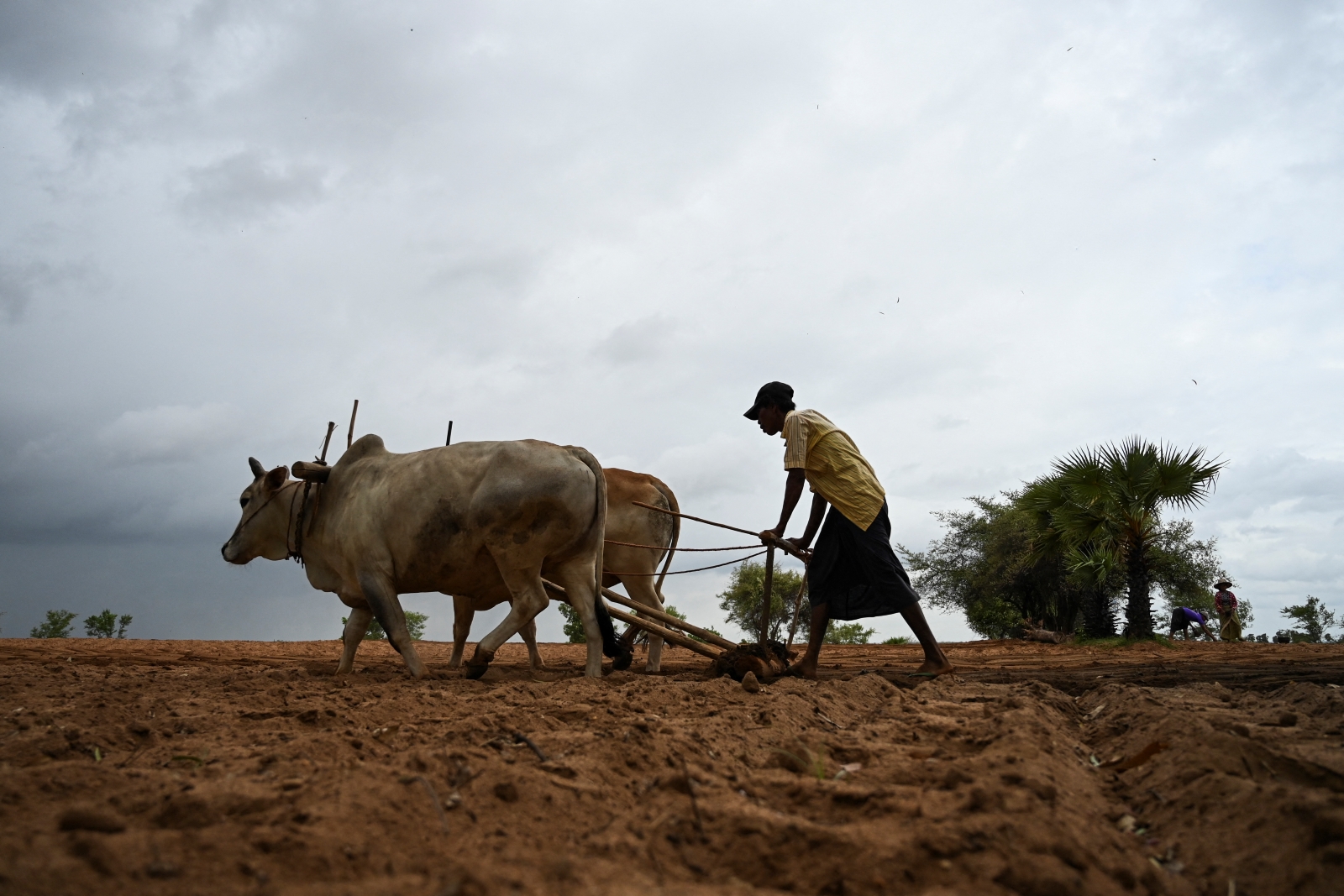Brave crews of underwater scavengers plunge into Myanmar’s waterways to search for scrap metal and salvage sunken vessels, a risky job that takes a heavy health toll.
By MOE THAW DAR SWE | FRONTIER
U Than Naung, a diver who makes a precarious living salvaging scrap metal from the Yangon River, is preparing to work. He fits a diving helmet with a breathing tube over his head, straps on a weighted belt with an attached mesh bag and a lifeline around his waist, and descends into the murky water.
He scrounges for iron, lead, copper, wood and even pieces of coal from the waterway, a distributary of the Ayeyarwady River that skirts downtown Yangon before emptying into the Gulf of Mottama.
Not long after Than Naung entered the river near the Kamakasit jetty, the breathing hose detached from the helmet, which filled with water. He quickly removed the helmet, put the breathing tube into his mouth and tugged on the lifeline to alert his assistant in the boat above that he was in trouble.
There was no response.
He jettisoned the diving belt and mesh bag and began rising nearly 20 meters to the surface, his lungs bursting as he held his breath.
“If my assistant had been paying attention he would have pulled me up when I tugged the lifeline,” said Than Naung, 56, complaining about losing the helmet and weighted diving belt.
The life-threatening drama took place in April in Dala Township. Than Naung said he has had at least five such mishaps since he began working as a salvage diver some 30 years ago.
There are two kinds of divers making a living on the muddy bottom of the Yangon River and other inland waterways. Informal scavengers like Than Naung recover items that can be sold, while more established companies will get paid by boat owners to recover sunken vessels.
Both have to rely on well-honed tactile skills developed over years of experience, a process they say have made their hands become their “eyes”.
“Even if we can’t tell it’s iron by looking closely on land, we know if we touch it underwater,” said 35-year-old Ko Thant Zin Oo, who’s been a diver for 20 years. “It’s the same with bronze.”
“Our daily earnings are uncertain, unlike construction workers or the porters who load and unload boats. They know they will earn K15,000 or K20,000 a day, but there are days when I don’t earn a penny,” said Thant Zin Oo. He said the most he can realistically hope to earn in a given day is K100,000 (around US$50), but on a couple of occasions he’s made as much as K2 million.
Divers like Than Naung have a small window of opportunity every day to do their work, as determined by the tide. The optimum period is between high and low tide, when there’s little current, which they call “water time” and only lasts around two or three hours.
There are five categories of workers, named after old Burmese coins. The lowest level is one maat, who does menial tasks on the boat and gets paid the least. The highest ranks are one kyat and five maat; they do the diving and get paid the most.
A working day usually involves moving from place to place, mooring the boat with a small, five-pronged anchor called a blair, and hoping to strike it lucky.
“When we attach the anchor, I go down and search. If we can’t find anything, we remove the anchor and find another place. Sometimes we have to search a lot before we find something,” Than Naung said.
The divers believe that most of the metal and other objects they salvage is jetsam from British and Japanese vessels that have been at the bottom of the river since before independence in 1948. After more than 75 years, they say there is less and less to find.
“These things don’t grow on their own in water,” said Thant Zin Oo with a laugh.
“I salvage everything I can find to make a living, because what we look for has become very rare,” said Than Naung.

Salvaging sunken boats
Thet Lwin Oo, now 35, first began diving for sunken vessels as a teenager with his father, who was taught in turn by his father. He has the red eyes, strong, large fingers and copper-coloured skin that are common features of salvage divers.
He first learned how to recover vessels while growing up in a village near the Ayeyarwady River in Sagaing Region’s Shwebo Township. But his reputation as a skilled diver has seen him called to work in the Chindwin and Thanlwin rivers and the waterways of Rakhine State.
About three years ago he moved with his family to the commercial capital because an increasing number of vessels were being recovered in the Yangon River.
“When our team is asked to salvage a vessel, the first thing we do is conduct a survey to calculate how long it will take to retrieve it and how much it will cost. Then we negotiate with the owner,” Thet Lwin Oo said.
He said they can earn between K10-20 million, depending on how many days the job takes, which is split among the team of eight he co-manages.
Apart from checking whether the boat is still structurally sound, the initial survey is also aimed at finding out how much mud or sand has accumulated inside it.
“I have to do this with my hands,” said Thet Lwin Oo. “Recovering a vessel is easy if it has not been at the bottom of a river for too long. But it also depends on the boat’s size; big vessels are more difficult,” he said.
If the boat owner agrees to the asking price, the team gets to work. They use two salvage methods, depending on the boat’s condition. If the vessel has not been damaged, it’s raised by attaching floating drums to the hull and pumping them full of air.
However, if the boat has been damaged it is usually cut in half with hacksaws and pulled to the shore in pieces. Thet Lwin Oo said cutting a boat in half under water can take a long time, especially as the cut needs to be as straight as possible.
If a boat has a metal hull an inch (2.54cm) thick, it can take an entire day to make a cut a metre long, he said.
“We take turns, at least two hours each. I go down for three to four hours,” Thet Lwin Oo said.
When the cutting is finished, the boat’s halves are pulled to shore by a bigger vessel, and the owner can sell it for parts.
“It’s a challenge taking on this work because if we fail, we lose our reputation. Once we start we can’t stop. We must succeed,” Thet Lwin Oo said.

A deadly job
In 2017, Thant Zin Oo, who normally works in the Yangon River, was asked to help in the recovery of a military Y-8 transport plane that crashed on a flight from Myeik to Yangon. The four-engine Chinese-made turboprop plunged into the Andaman Sea about 70 kilometres southwest of Dawei killing all 122 passengers on board, including soldiers and their families.
Thant Zin Oo said the military asked his team to help with the salvage operation, which involved raising the fuselage using airbags. It was a job that proved fatal for one of his colleagues, U Saw Naung.
Thant Zin Oo said he and Saw Naung dove down 35 meters with diving suits and oxygen tanks to the seabed to attach the airbags and returned to the surface after they were inflated.
“I went first but after we boarded the Tatmadaw recovery vessel and removed the diving suits provided by the army he collapsed and lost consciousness,” he recalled.
The people around him said he had been touched by ye nhar, decompression sickness, and suggested sending him back underwater, a procedure known as in-water recompression, which is only recommended as an absolute last resort.
Thant Zin Oo said Saw Naung regained consciousness after being dunked underwater, but lost consciousness again when he was brought back to the ship each time.
“After doing that two or three times, I became scared and didn’t dare do it anymore. The military took him to Dawei General Hospital before he was transferred to the 1,000-bed Defence Services Hospital in Yangon’s Mingaladon Township, where my friend died three days after being admitted,” Thant Zin Oo said.
“I was also affected, but I did not lose consciousness. My body, hands and feet ached,” he said, adding that given his experience diving in rivers, he was totally unprepared for the pressure of the ocean.
Thet Lwin Oo said even diving in the rivers can cause health problems over time, including eye pain, ringing in the ears, trouble hearing and persistent headaches.
“The deeper the water, the harder it is,” he said.
Than Naung said another health risk is commercial respirators that use compressed air instead of oxygen, causing lung damage.
“People get cold when they work in water every day and it affects the muscles and joints,” he added.
On the day Frontier interviewed Than Naung, he told friends his body was aching and he did not feel well. One of them gave him a traditional Burmese medicine – a mixture of more than 20 ingredients including liquorice, clove, sandalwood and coriander – to dissolve in water and drink.
At 56, Than Naung is one of the oldest divers working in the Yangon River. He no longer has the stamina of his younger years and is bone tired at the end of each day.
“I’ve been diving for more than 30 years and don’t have as much endurance as before,” he said, adding that he expects he’ll have to stop working in around two years.
“But when I retire from this job my future is uncertain because I don’t know what else I can do.”
Moe Thaw Dar Swe is the pen name of a Myanmar freelance journalist.







